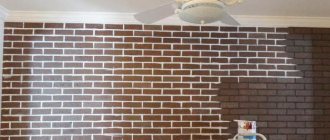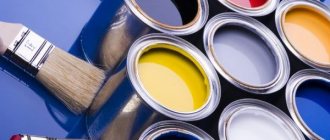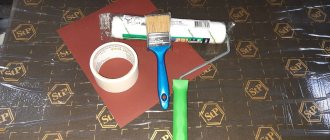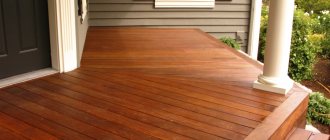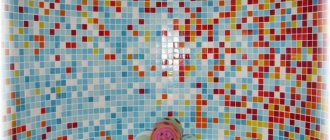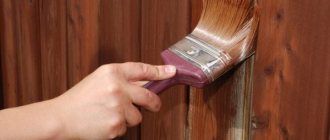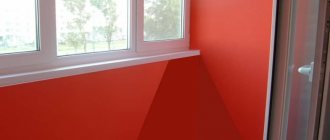- Required materials and tools
- Choosing the right paint
- In what order should the work be carried out?
- How to repair cracks
- The right primer
- How to apply paint to a brick wall
When the brickwork of a house is smooth and neat, it does not need to be plastered, but simply painted.
This is to prevent moisture from getting under the brick and mortar. Excess moisture can cause the wall to collapse over time. And of course, this will not only protect the masonry, but also decorate your interior. Below we will look at how to paint a brick wall yourself. Painting a brick wall is necessary to prevent moisture from getting under the brick.
Brick walls can be painted not only from the outside, but also from the inside. A good design solution could be to paint those places on the walls where the brickwork is visible.
Especially inside a living space. For this, it is best to use special, breathable paint. To paint a brick wall in a bathroom or dining room, use a waterproof paint. Acrylic paint is ideal for a hallway.
Required materials and tools
What might you need for painting? Everything depends primarily on the wall, on its condition, and also on whether it is façade or interior. But let's take things in order. You need to prepare the following tools:
Before painting, the wall must be cleaned of the old coating and sanded.
- wire brush or sponge;
- roller or brush, preferably with stiff bristles;
- sponge;
- spray;
- scraper knife;
- sandpaper;
- protective glasses;
- latex gloves.
You will need the following materials:
- wall cleaner;
- dye;
- cement;
- grout;
- primer.
To avoid wear of tools on the rough surface of the brick, purchase high-quality and durable tools - rollers, brushes and brushes.
Return to contents
How to paint brickwork
If your brick house has just been built, you should wait at least 12 months before painting it. During this time, the building will shrink.
Preparatory work
- First of all, all cracks and crevices on the base are covered. This is done with cement-sand mortar.
First of all, the base must be cleaned and washed.
- Next, the base is cleaned of old coating, dust and dirt. Especially if the house is not new and was decorated in an antique style.
Heavy dirt can be removed from bricks using a grinder.
- First, the walls are cleaned with a spatula, grinder or metal brush. At the same time, cement build-ups and efflorescence are removed from the base.
- Then the surface to be treated must be washed with water from a hose.
- After this, residual contaminants are swept away from the brickwork with an ordinary brush.
- The still wet base must be treated with a special façade cleaner.
The cleaned wall must be primed.
- After the brick surface has dried, a primer is applied to it.
Applying paint
Brick is best painted with a brush.
The optimal tool for applying paint and varnish to brick is an ordinary brush. It makes it possible to completely paint masonry joints.
To prevent paint from getting where it shouldn’t (windows, doors, etc.), untreated areas of the base should be covered with plastic film. You can lay cloth or old newspapers on the floor.
The brick base should be painted in two layers. When the coating is applied for the first time, you must wait until it dries. This time period is indicated on the material can.
External brick walls need to be painted when there is no rain and it is warm outside.
Brick facades must be painted in warm and dry weather. It is highly desirable that it is not sunny in the next day or two.
Choosing the right paint
Regardless of which brick wall you are going to paint, external or internal, in any case it is best to use facade paint. Particularly interesting are the following types of paint:
Latex paint for bricks is elastic and bonds cracks well.
- Acrylate.
- Latex.
- Acrylic.
This coloring agent is designed specifically for porous and heterogeneous surfaces.
Brick paint has its own differences from any other types of coloring agents. First of all, it is more elastic and penetrates better under the masonry. Such interesting properties allow it to glue cracks and small gaps between masonry.
When buying paint at a hardware store, ask a consultant what kind of walls it is intended for. There's one that's great for painting worn walls, and one that's perfect for covering new masonry. That is, the differences lie in its composition, in the operational period, and, of course, in quality. To work with a small area of the surface, you can use enamel or acrylic. These types are perfect for interior painting work.
Return to contents
What requirements must paint for brickwork meet?
First of all, you should consider whether the paint will be used for exterior or interior use. After all, the finishing experiences different types of influences.
Coverage parameters: 10 aspects
The composition for application to brick must have the following qualities:
- Moisture resistance . With a high level of water permeability, cracks form on the finish, it begins to peel, and efflorescence and mold appear on the walls. This will ruin the appearance of the brick house and affect people's health. A brick wall that is moistened from the outside freezes in winter and expands as a result. Ice appears on the surface and destroys not only the paint, but also the base.
When exposed to moisture, efflorescence appears on the brick, so the paint must be waterproof.
- UV resistance . Due to exposure to sunlight, paint that is not resistant to sunlight can fade, crack, swell and crumble. On the outside, the coating changes tone and the walls become multi-colored. On the south side of the house they become lighter, and on the north they retain their original tone.
A coating that is not resistant to sunlight will quickly crumble.
- Vapor permeability . Brick is a porous material, so it allows fumes from the premises to escape outside. Facade paint must also be vapor-permeable. Otherwise, the microclimate inside the house will worsen and mold will begin to multiply.
Without good wear resistance, the paint will wear off in 2-3 years.
- Wear resistance . The coating is subject to the greatest abrasion when the base is washed and where people often come into contact with it (for example, near windows and doors). On the dye can, the manufacturer states the number of washes it can withstand before it is completely worn out.
- Durability . The coating must be resistant to scratching, mechanical stress and abrasives.
- Covering power . The better this parameter, the less paint is needed to cover 1 m² of surface.
Good hiding power reduces paint costs.
- Drying time . The paint coating of the brick consists of two layers. Therefore, the faster the finish dries, the better.
- Elasticity . When temperature changes, brick walls expand and contract. Due to its plasticity, the coating will not be damaged during these movements.
- Adhesion level . The coating should adhere well to the base. Reliability of the adhesion is important both for the brick surface and for the masonry mortar.
- Service life of the paint layer . It depends on the type of paint and the manufacturing company. However, in general it is no more than 10–20 years.
The average lifespan of masonry paint is about 10 years.
Requirements for finishing fireplaces and stoves
Separately, it is worth mentioning paint for a brick stove or fireplace. They become very hot during use. Conventional paint coatings quickly burn out and begin to peel off.
The most important parameter of the finish that will be applied to a stove or fireplace is its heat resistance and heat resistance. Manufacturers produce special paints for heating devices. This is indicated on their packaging.
Special heat-resistant paint is produced for brick heating devices.
In what order should the work be carried out?
Basically, all painting work is carried out in 3 stages, these are;
Before painting, the wall must be thoroughly primed.
- The preparatory stage is the preparation of the wall that is planned to be painted.
- Padding.
- Coloring.
You need to start with preparation. This will determine how long the paint will last. Proper preparation should include the removal of all wall defects - small cracks, irregularities, bulges. If the wall is not absolutely flat, then high-quality painting will not work. Keep this in mind when preparing the surface for painting. Using a scraper and sandpaper, remove all visible defects and proceed to sealing cracks.
Return to contents
Preparing a brick wall for painting
To achieve a high-quality result, the wall must be carefully prepared before starting painting work. Processing of brickwork includes several stages:
Cleaning the wall. This can be done using a metal scraper and detergent. Areas with old paint or whitewash are treated with a solvent. Dirt, soap, and coating particles are washed off with water.
Removing efflorescence . Any salt deposits on the wall are removed using a stiff brush. After this procedure you will have to wait a few days. If salt crystals appear again, the surface will have to be treated with a special product containing acid or ammonia.
Sealing cracks. Small cracks can easily be covered with latex or alkyd paint. Large cracks will have to be sealed with cement mortar. To do this, they must first be thoroughly cleaned of dust and crumbs of old cement. After applying the solution, the wall is leveled with a brush. Then the wall must dry for at least 10 days. Excess dried mortar can be removed with a spatula.
Important! After washing the wall, you need to wait about a week for the absorbed moisture to come out of the pores of the brick.
Primer. The statement that a brick wall does not need a primer is erroneous. Here are a few reasons why priming masonry is an important step in preparing a wall for painting:
- primer improves paint adhesion;
- provides water resistance;
- reduces paint consumption;
- increases the durability of the coating.
Tip: for best results, choose a primer that has the same base as the paint you choose.
The wall needs to be primed in several layers, each subsequent one is applied only after the previous one has dried. If greasy stains appear on the surface, several additional layers of primer are applied to them.
How to repair cracks
First, use detergent and a stiff wire brush to scrub the entire surface to be prepared. Remove all whitewash residues and traces of old paint if the wall has been painted before. You can also use a solvent for these purposes, it all depends on how uneven the surface is.
When painting a wall, you need to protect your eyes with special glasses and wear gloves on your hands.
If there is mold or limescale stains on the wall, then the masonry will not last long. Moisture absorbed from outside accumulates in such places. Accordingly, it is necessary to eliminate the presence of mold and plaque. For this, special solutions are usually used. Using a brush, brush all areas where mold and stains are visible with the solution. Finally, rinse the solution with water. When working with the solution, follow safety precautions - wear safety glasses and gloves.
Now carefully examine the entire surface of the treated wall again. There should be no defects on it. If there are small cracks, it's okay, they will be repaired with paint. If there are strong cracks, they need to be cemented. Clean them from dust and dirt, then seal them with cement mortar.
The next step is to level the wall using a washcloth or brush. When the entire preparation process is completed, the wall should be dried. The period of complete drying can take from 10 days to 3 weeks. The main thing is that the surface becomes completely dry, otherwise after applying a layer of new paint, fungi and mold will form after some time. When the wall dries, you can move on to the next stage - primer.
Not plastered. However, the brick cannot be left in completely original condition. Both the solution and the material itself must be protected from the passage of time, as well as the possibility of them absorbing moisture. It is for this purpose that a brick wall is painted.
Of course, it is advisable to use such a method in cases where the masonry is ideal and the brick has a presentable appearance. In this case, such a texture will decorate your interior, especially when using bricks that have an unusual shape or color. But a skillfully performed procedure will significantly improve the aesthetic appearance of the old masonry and mask the imperfections that have appeared under the influence of time.
Things to consider before painting
If you are thinking about how to beautifully paint a brick wall, consider a few nuances:
Fortunately, the disadvantages are easily compensated by the advantages that painting entails:
- you will divert attention from wall defects that have been affected by time;
- you can change the color of the masonry so that it fits better with various interior details, when it comes to interior walls, and other buildings when you are working on the facade of a building;
- create a fashionable, modern style.
How to paint a brick wall inside a house
Rating: 5.00 (votes: 3 ) Loading.
Lately, brickwork has been used very often in interior design solutions. A brick wall is used in interiors with a loft style - it is made specially, or in brick houses you can simultaneously make renovations in a modern style and preserve the history of the building. And the simplest solution for updating a brick interior is to paint it. How to paint a brick wall inside a house , what paints and tools to choose, we will tell you in this article.
Choosing paint
Having decided to do it yourself, pay special attention to the choice of paint, depending on the location of the wall (external or internal), your requirements for coating, and the quality of the masonry. The following paint properties play an important role:
- light fastness (resistance to ultraviolet rays);
- waterproof (protection from precipitation for the facade and the ability to wash the surface for interior walls);
- alkali resistance (the ability not to be affected by alkali contained in cement mortars);
- vapor permeability (a brick wall must be able to “breathe”);
- good adhesion;
- durability.
Brick painting
Additional characteristics include the speed at which the paint dries, consumption, and, if necessary, the possibility of tinting. Think in advance what kind of surface you want to create: matte, glossy, semi-matte. Your wishes will influence the level of reflectivity required.
If you have to paint a brick wall or just outside, it is advisable to give preference to facade paint intended for use on masonry.
Elastomeric paint also deserves attention. Despite the relatively high cost and complexity of work, one cannot fail to note such qualities as frost resistance and the ability to plug masonry cracks.
Acrylic latex paints also have the necessary properties; the resins underlying them form a waterproof film on the painted surface, protecting it from exposure to the external environment.
Inside, the paint does not require frost resistance and great ability to repel water (except for walls in the bathroom), so it can be done using acrylic paints, as well as silicate ones.
Oil products, although they look great, are not suitable for this purpose. They form an almost impenetrable film, resembling a crust, and do not allow the surface to “breathe”, which in the future will lead to the gradual destruction of the brick wall. But masonry that is in perfect condition can be covered with several layers of transparent varnish. This will give your design a touch of vintage and will allow you to preserve the interesting palette and texture characteristic of high-quality brick.
Types of coatings
For DIY repair and restoration work, water-based or organic-based brick paint can be used. Water- and organic-soluble compositions have their disadvantages and advantages:
Organosoluble nitro enamels and oil dyes
They penetrate well into the brick structure, are resistant to UV rays, but create a thin, durable water-repellent film on the surface, which prevents the material from “breathing” and provokes the formation of condensation.
It is not recommended to use organosoluble mixtures in the interior of a residential building: the walls will become damp and the internal microclimate of the premises will be disrupted. Well suited for painting facades, brick balconies and fences, they provide complete protection from atmospheric agents, do not fade, but are toxic.
Water soluble
These paints are very durable and are used for painting exterior walls. They can even paint a brick chimney for a heating stove or a gas heating chimney, as well as carry out finishing work inside the house. Suitable for plain, sand-lime and gypsum bricks or gypsum tiles (imitation brick).
Water-soluble facade paint
They have good vapor permeability, ensuring complete water and gas exchange between the atmosphere and the surface. Non-toxic, fireproof, they can be used to decorate indoor interiors. Can be produced with heat-resistant qualities.
If the tile covering is ceramic, you need to look towards special paints for tiles.
Epoxy
They have different qualities. Depending on the resins they contain, they can be toxic or non-toxic. They are distinguished by increased adhesive properties and strength, but are weakly resistant to atmospheric conditions. Painting a brick wall with gypsum bricks or tiles for indoor interior decoration can guarantee the quality and durability of the coating. They can be used to paint the inside of a covered balcony.
To increase weather-resistant properties, such dyes can be varnished. For living rooms, it is advisable to select non-toxic solutions, carefully reading the composition and scope of application on the packaging.
Mineral
Cement-based brick paint is well suited for facade work, for decorative painting of a facade, balcony or fence. It has high water and heat resistance, can withstand the onslaught of heavy rains and temperature changes, reliably protecting the fence or facade of a building from destruction. It is rarely used for interior decoration.
Silicone
When choosing how to paint brick or decorative tiles with low adhesive properties (usually silicate products), it is better to choose silicone mixtures that adhere well to a smooth surface and do not fade for a long time. They can be produced with heat-resistant properties - for decorating stoves and fireplaces in the interior.
Surface preparation
When you are going to paint a brick wall yourself, you need to pay sufficient attention to preparing the surface to be treated. It is in many ways more complex than the process of dyeing itself, and to achieve the best result it is necessary to take into account a number of requirements for the preparation technology.
If carefully followed, these instructions will help make further work as easy as possible and avoid unpleasant surprises in the future.
Exterior wall painting process
Which brick paint to choose for external and internal work?
It would seem like paint and paint, I bought it and painted it, but don’t rush to run to the nearest paint store! The fact is that it is not for nothing that there are many types of it. You should not use the same one for the interior and exterior, since they differ from each other in composition and technical properties.
What paint should I use on the outside of a brick wall?
To answer this question, you need to understand what qualities it should have. After all, many would like to simply paint the walls and forget about them for the next 10 years. This is quite possible with modern paints, if you choose an option that meets the following requirements:
- The paint should be well absorbed into the brick; this will prevent it from cracking and peeling over time under the negative influence of the external environment.
- Paint for bricks for exterior use should have good water resistance, but not allow moisture to pass through in large quantities; this will protect the brick from the penetration of salts onto the surface and prevent it from delaminating.
- Vapor permeability - “breathable” paints will last longer unchanged. In summer, under the influence of the sun, such paints do not dry out and, as a result, do not crack.
- High-quality paint should not fade quickly, otherwise the walls will have to be repainted every 1-2 years.
The length of time that painted brick walls remain unchanged also depends on what color of paint you choose. The richer and darker the color, the faster they lose their tone when exposed to the sun. The situation is somewhat corrected by glossy paints, since they reflect some of the rays. With white tones everything is much simpler - there is nothing to fade.
Paint for bricks for exterior use photo
Of all the types of paints that exist today, acrylic-silicone-based paint is best suited for exterior work; it meets all of the above requirements and has increased resistance to the external environment.
Water-based paints are often used to decorate brick walls; their main advantage is high-quality vapor permeability, they are also odorless, fire-resistant and dry quickly.
Due to the low cost, people looking to save money often paint brick walls with acrylic paint.
Which brick paint is suitable for interior work?
The main parameter in this situation is chemical purity; there are already enough chemicals in our homes, why make the situation worse. It is also recommended to use “breathable” paints for painting brick walls in the interior - in this situation we take care of a favorable microclimate in the room. In addition, if the walls do not absorb and release moisture, condensation may form on them. The ideal option of all is water-based paints; moreover, they can be easily adjusted using a color scheme to the desired tone, which is important when decorating the interior.
Brick paint for interior use
How to paint a brick wall correctly
If you plan to paint an external wall, then it is better to carry out the work in the warm season with a temperature of at least +25 °. Otherwise, it will not be easy to ensure that the paint lays down in an even layer without streaks. Painting interior walls requires first removing furniture from the room. Also try to protect horizontal surfaces by covering them with oilcloth.
When thinking about how to paint a brick wall, keep in mind that work should be done indoors using a roller with a fairly long pile (2 cm) or a brush. Painting is done in stripes, and the overlap should be 1-2 mm. External walls can be easily painted using a spray bottle for this purpose.
In both cases, it is preferable to start from the top corner and apply 2-3 layers, and for the first one the paint should be diluted a little, and each subsequent one should be applied as the previous one dries. The texture of most high-quality paints is good because it allows you to hide minor mistakes by the painter, but still make an effort to paint as carefully as possible. Do not forget that the surrounding areas must first be covered with masking tape, and film or newspapers should be spread near the wall, otherwise you will spend a lot of time trying to erase traces of dried paint from the floor.
In addition, an effect similar to painting can be achieved when working with a facade if you choose colored bricks. Modern technologies make it possible to introduce the necessary dyes into the composition of sand-lime bricks at the production stage. At the same time, sand-lime bricks used for the construction of buildings are not subject to such coloring, but the facing ones are presented in the building materials market in a wide variety of shades.
Requirements for paintwork materials for brick bases
The modern construction market offers a large selection of paints and varnishes for finishing brick facades and for interior finishing of brickwork. Products are also divided based on operating conditions - there are waterproof and heat-resistant compounds. It should be noted that facade paint can also be used for interior decoration, but interior products are not suitable for exterior use.
The following requirements apply to the coating:
- Vapor permeability. A brick wall must allow condensation to pass through, which occurs during the operation of the house. Therefore, the paint and varnish material must be vapor permeable, otherwise all the moisture that has accumulated in the pores of the brick base will penetrate between the wall and the coating, causing the coating to peel off.
- Resistant to water and humidity. The brick wall is exposed to precipitation. The paint composition must withstand exposure to water and high humidity. This is true for external and internal coatings.
- UV resistance. Over time, direct sunlight can cause the shade to fade. The paint must contain special additives that could protect the surface. The color loses its effectiveness in areas that were painted in dark colors.
- Elasticity. Elastic material fits much better on the brick surface. The plastic mass withstands well various deformation changes that occur in a brick wall during seasonal temperature changes - the coating will not crack.
- Covering power. If the material has good hiding power, paint consumption will be minimal. This is important if a wall is painted based on microporous honeycomb bricks. Not all products on the market are capable of providing high-quality coverage when applied in 2 layers.
- Resistant to low temperatures. This is a particularly important requirement. Many modern paints contain special additives that allow the coating to withstand extreme temperatures and harsh climatic conditions.
Also, coloring compositions must be environmentally friendly. Modern manufacturers supply products based on organic compounds and on a water-dispersed basis.
On video: how to paint brickwork.
How to care for painted brick walls
If you carefully complete all stages of the work, you will subsequently notice that painting a brick wall in the interior or exterior of a building did not require much labor or significant expense. But the care required for painted walls is quite simple: when they become dirty, they need to be washed using a regular soap solution for this purpose.
If necessary, individual fragments of the coating are restored without applying paint to the entire surface. The newly painted areas will blend in with the rest relatively quickly if you used high-quality paint that is resistant to environmental influences.
The need to paint brick surfaces arises quite often. This could be the repair of facades, “budget” finishing of walls inside industrial premises, or, for example, upgrading the space on the balcony.
In principle, this kind of work is not difficult to do - you just need to follow certain rules and then everything will turn out beautifully. And if you adhere to the technology published below, then a little paint will be used and it will last a long time.
Therefore, you must agree, it’s definitely worth studying the principle of proper painting.
Let's start with the most important thing.
How to make the right choice?
In order for fences, facades, and balconies to please the owners with their elegant and spectacular appearance, and for the interior brick elements to not crack, you need to choose the right paint to treat the surface with. To get high-quality brick painting, you need to remember some nuances:
- The composition must have low consumption for different types of surfaces.
- High-quality mixtures will work well on any walls or types of gypsum tiles. Working with paint should be as convenient as possible.
- Drying speed is very important for outdoor work, when precipitation can greatly damage a coating that has not yet hardened enough. In interior decorating work, drying speed is not important.
- To maintain its appearance for a long time, the surface must be cleaned. Painted surfaces must be cleaned using water and detergents.
- Tinting. If the desired paint color is not available, the product must be able to create the desired color by adding the desired pigment. Not every product can be tinted.
- Resistant to UV rays. This property must be taken into account when choosing a composition for outdoor use. The use of coatings whose light resistance is not high will lead to a rapid loss of the appearance of the brick. For interior work, paint based on the level of light resistance is selected based on the shading of the interior.
- Heat resistance. For exterior finishing work, dyes that are resistant to low temperatures should be used. For interior work, it is best to use heat-resistant materials.
- The material must provide reliable protection to painted surfaces. Thus, the coating must be protected from mechanical damage, as well as aggressive environmental influences.
Reflective properties are also important. Matte brick paint is suitable for finishing gypsum tiles or pre-leveled brick walls. Fences, balconies, facades will not look very aesthetically pleasing - various irregularities are clearly visible on the surface. These defects can be easily removed using glossy materials.
With the right approach to choosing paints and varnishes, you can get an excellent result that will delight you with a pleasant appearance and good protective characteristics for a long time.
Rules for painting bricks (2 videos)
Paint from different manufacturers (20 photos)
How to paint
You can often see brick walls painted with whatever was at hand. On the one hand, this is economical - you don’t need to spend money on buying new material, but on the other hand, it is unreliable. Because unsuitable paint will begin to peel off from the plane of the wall within a season and become covered with cracks.
Alkyd paints
This is an excellent and durable option with a fairly large selection of colors. In fact, these are the usual paints in iron cans. They are made on the basis of alkyd resins (they are obtained by boiling various vegetable oils) and acids.
The good thing about the material is that it holds firmly when it dries and does not emit any toxic or unpleasant odors.
But there is also an unpleasant moment - during painting the “aroma” will be such that just hold on.
The disadvantages include the fact that the price of the paint is not very low. In addition, the consumption per square meter is large.
Tip: to reduce paint consumption, use solvents. The color is not lost from them, the strength of the layer is also not compromised, but the material will be used more economically. And besides, if the paint is diluted with the same “White spirit”, for example, then it will be easier and faster to apply.
Next option.
Acrylic and other water-based paints
These are paints based on components made from acrylic resin. They are distinguished by the good appearance of the layer in the end, low consumption, variety of colors and prices - you can choose a material to suit any budget.
In addition, acrylic products do not emit strong odors - thanks to this, you can work with them even in a residential area, without fear for the health of others.
The disadvantages include the not very high strength of the final layer, and also the fact that cheap options do not cover minor plane defects, unlike alkyd analogues.
In general, if we talk about what paint to paint a brick wall, then both options are quite suitable for such work.
Now let's look at how to actually paint.
Paint choice: outside and inside
There are many requirements for paint for painting bricks. The same paint is not suitable for working on an external wall and indoor brickwork.
Outdoor wall paint
If you are going to decorate an external wall, for example, on an open balcony, you will need façade paint. But not just any composition is suitable for outdoor work; it must necessarily have the following properties:
- high light fastness;
- alkali resistance – the cement mortar that holds the masonry can negatively affect the applied coating;
- waterproof - protects against precipitation, prevents unwanted moisture absorption;
- high adhesion – adhesion to the surface being painted;
- vapor permeability - a brick wall must “breathe”, providing a microclimate inside the room;
- durability;
- resistance to damage.
Acrylic latex, silicate and silicone paints have the necessary characteristics.
- Acrylic latex paint creates an excellent waterproof coating, prevents the appearance of efflorescence - white salt stains, and has excellent elasticity and hiding power. Its disadvantage is low vapor permeability.
- Silicate paint has excellent vapor permeability, which compensates for its low water resistance due to the rapid evaporation of water and resistance to microorganisms. Among its disadvantages include low elasticity and the inability to bridge small cracks.
- Silicone paint does not allow water to pass into the walls, while allowing air to circulate through the coating, protecting the wall from contamination. Thanks to its increased elasticity, it covers two-millimeter cracks. A unique property of silicone paint is the ability to apply it to a brick wall within two days after the wall is erected. With all its advantages, this paint is not available to everyone due to its high cost.
Paint for a brick wall in a room
There is an opinion that indoors you can successfully use facade paint that is well suited for the porous surface of brick. But many formulations may be unsafe due to the volatile substances released. To paint a wall in a room, you need to choose a water-based and adhesive-based material.
Alkyd paint will create a semi-gloss effect, acrylic will give a matte surface. If the area to be painted is small, you can choose oil paint, which will give the brick a soft shine.
For rooms with high humidity - bathroom or kitchen - special moisture-resistant materials are suitable. For a brick fireplace, you need to choose a heat-resistant composition.
Painting a brick wall step by step
For work we will need the following tools and materials (except for the paint itself):
- bath and roller;
- brushes of various thicknesses;
- masking tape;
- solvent (for alkyd paints);
- wall primer and large brush;
- bucket;
- spatula to remove remaining solution.
As you can see, you need little equipment and there is nothing expensive in it.
Let's start working with our own hands:
- Using the wall, we clean it of debris and excess mortar.
- We glue masking tape around the entire perimeter of the ceiling and floor, where they adjoin the wall. If you don’t do this, you will certainly stain the ceiling or floor - tested in practice.
- Pour the primer into a bucket, take the largest brush and carefully treat the entire wall. This is necessary so that the paint adheres better to the surface and, of course, for less material consumption - due to the presence of a primer, less paint will be absorbed into the wall structure.
- We take a brush and first process all the seams between the bricks. Make sure there are no drips or drips.
- Pour paint into the tray, wet the roller well so that approximately the same, uniform amount of liquid is obtained over its entire area. We paint the wall using movements from bottom to top and vice versa. In this case, it is important to ensure that there are no stripes left from the edges of the roller on the plane of the wall.
Please note that you also need to squeeze it thoroughly after dipping it into the paint. If you do not do this, then there will be too much liquid on the instrument, which will simply splash in all directions and drip onto the floor. And if you don’t squeeze it out, you won’t be able to create a uniform, monochromatic layer on the wall.
In principle, this is the end of the painting. Look at the result - if the color does not seem too saturated to you, then you can try applying another layer of paint. There is no need to prime the previous layer.
Well, now a few words about the design.
Requirements for facade paint for bricks
To obtain a high-quality coating for the facade of a house, you need to choose an exterior paint that will meet certain requirements.
These include:
- high level of vapor permeability . It allows condensate diffusion processes to occur freely and the material to “breathe”;
- waterproof properties . The material must provide reliable protection to the wall from precipitation;
- resistance to UV rays . The paint should not crack or peel when exposed to sunlight, or lose its original appearance;
- degree of durability . The frequency of restoration work depends on this characteristic. If you choose a paint that is not too durable, you will have to repaint the house once every 2-3 years;
- material consumption per 1 m 2. This parameter varies for each paint coating individually. It is better to immediately pay attention to this characteristic when purchasing, because the lower the paint consumption, the more surface area you can paint with the volume of composition of one package;
- drying speed . Basically, this parameter depends on the temperature, but it can vary for different brands. It is not recommended to choose quick-drying paints and varnishes, since working with them is not very convenient;
- degree of adhesion . This characteristic is quite important, because painting a wall can be done without prior priming, which means that the paint should adhere to the main surface as well as possible.
Painting options
There are several main ways to paint a brick wall. Let's take a look at the most popular methods.
So, how to paint a brick wall - a few simple ideas:
- The entire wall is rolled up with paint of the same color - the advantage of this method is the high speed of the work.
- Painting the bricks one color and the seams between them another. If you do this, it will turn out contrasting and quite beautiful. Only it will take a little more time than in the first case.
- Painting the bricks themselves in different colors. It turns out interesting, but here you spend more time and money - after all, you need to buy paints of different colors.
These are the solutions. In principle, a lot depends on your imagination - if you wish, you can make a textured brick surface from a completely smooth plane. To do this, you just need to first paint the entire plane with one color, and then mark the lines with upholstery cord and apply paint to them with a brush.
That's all!
Let's summarize.
What paints are used?
For external work
Painting bricks outdoors requires the following qualities from the dye:
- high resistance to aggressive weather conditions: rain, snow, wind and others;
- resistance to sunlight and, as a result, fading;
- durability;
- good adhesion - often applied to bare brick.
For interior work
Painting bricks inside a house is recommended with a dye with the following properties:
- non-toxic;
- high fire safety;
- vapor permeability of walls (otherwise the rooms will be damp);
- resistance to mechanical damage.
Conclusion
We have discussed in detail how brick walls are painted, how it can be done, and what design options there are. We even looked at how to paint a wall to look like brick. We hope that you will be able to apply the acquired knowledge in practice.
Well, if the information provided is not enough for you, then we advise you to also watch the video in this article.
It’s worth thinking carefully about whether this is necessary. By its nature, brickwork is not intended for painting. If the need arises to remove paint from it (due to negligence or defective work or a desire to insulate the walls with a layer of plaster) or replace paint that has faded from age, be prepared for the fact that it will be very difficult to complete such work. This is especially true for expansion joints.
What to look for when buying paint and varnish products
In order for the fence to please you with its presentable appearance for a long time, and for the balcony and outside walls of your home to not crack, requiring repeated repairs, you need to choose the right coating. When choosing how to paint a brick with your own hands, it is important to take into account:
Exterior brick paint
- Economy. Consumption for different types of surfaces (brick, gypsum, ceramic tiles) and depending on the properties of paint and varnish compositions will vary.
- Convenience. The high-quality mixture fits well on walls or tiles and is easy to use.
- Fast drying. This quality is important when carrying out external work, when precipitation can spoil wet paintwork. For interior decoration inside buildings, this quality does not play a big role.
- To maintain a decorative appearance for a long time, the paint must be easy to clean. Painted surfaces should be easy to clean from dirt and wash with water. To impart such qualities, some dyes can be varnished.
- Tinting option. Is it possible to add an additional shade to the paint mixture using color additions? Some formulations do not allow this possibility.
- Light fastness, resistance to UV rays. This quality especially needs to be taken into account when carrying out work outside (painting a balcony, facade or fence). The use of dyes with poor light fastness can lead to buildings quickly losing their beautiful appearance. When working on interior design, light resistance is selected taking into account the shading of the premises.
- Heat resistance. For exterior work it is necessary to use frost-resistant paints; to decorate stoves and fireplaces in the interior of a house, heat-resistant dyes are needed. Heat-resistant paints should be used for stoves and fireplace pipes.
- Resistance to external influences. Painting compositions must reliably protect walls, balconies or fences from damage and environmental influences. Reflective properties (matte or glossy). Matte is well suited for gypsum tiles or well-leveled brick walls. A fence or balcony of a house painted with such a building mixture will not look aesthetically pleasing, and unevenness will become visible. Such defects can be easily hidden using glossy dyes.
Why do you need to paint brick walls?
Nevertheless, brick has been painted almost since the beginning of its use in construction. Quite often it is even advisable to paint a brick wall or an old brick fence. For example, when the masonry has minor but noticeable damage to the naked eye or salt crystals appear on its surface - efflorescence.
The need to paint an external brick wall may also arise if, under the influence of time, sun and precipitation, the brick has faded, losing its original color and brightness. In this case, the painting, provided it is matched to the tone, will return the brick to its original appearance.
Recently, painting brick walls has become fashionable among designers and decorators. This design technique can give a brick house a special chic and individuality at minimal cost.
Whatever the reason for painting a brick wall, this operation must be approached very responsibly. With the wrong choice of material or carelessly executed painting, a brick house can turn into a sealed, damp box, losing the remarkable ability of a brick wall - good vapor permeability.
Return to contents
How to paint brick?
Painting sand-lime brick is not a complicated process. To cover a wall with paint, use standard tools: roller, brush, sprayer. In order for the mixture to adhere well, the surface should be pre-prepared:
- The surface must be dry. You need to make sure that the brick is not wet.
- Apply only to a base that has been cleared of old dye. Previously painted bricks must be thoroughly cleaned and washed. Wipe off dust, mold, excess solution, dirt.
- Be sure to clean off the white deposits - these are salts washed out of the brick by moisture. Before painting a brick wall, you should clean it thoroughly with a brush and/or water.
- It is advisable to use a primed surface. This technique will be more expensive, but the quality of applying the mixture to the wall will be significantly higher.
Return to contents
Paint consumption
It is worth especially carefully studying the question of the required amount of paint per 1 m². Often, a cheap dye with good qualities is actually consumed in larger quantities than a more expensive one. This ultimately leads to painting with lower quality paint, but at the same time it costs more. You can find out what the paint consumption is by studying the label on the can or from a consultant in the store.
Features of paint selection
Brickwork has a porous, rough surface, which is also uneven due to cement joints. It is extremely difficult to paint such a surface with regular paint, so a special façade paint was developed.
But when purchasing such paint, you definitely need to look not just for facade paint, but specifically for painting brickwork. Even more, façade paints have been developed for painting separately old and new masonry, which have certain differences in their compositions.
Most specialized paints developed for painting brick have increased elasticity and are able to penetrate deeply into the surface material, leveling it and, thanks to its elasticity, gluing cracks.
A good solution for exterior masonry is to paint it with elastomeric paint. With its help, you can reliably protect the wall from moisture and seasonal temperature changes, in addition, it will reliably seal all cracks in the brickwork. But be prepared right away that when working with elastomeric paint, you will have to put in a lot of effort. This paint has a consistency much thicker than regular façade paint, and it also needs to be applied in a layer 3 times thicker. It's expensive.
For interior painting, there is much more choice. Interior walls can be painted with paints on various bases. But when making a choice, you must take into account that the paint must be resistant to alkaline environments, and if we are talking about a bathtub, toilet or kitchen, it must also be water-repellent. For fireplaces and stoves, only special heat-resistant paints should be used.
In addition to the same facade paint for brickwork, you can use acrylate, latex or acrylic. All these paints do not fade under sunlight for a long time, maintaining their original brightness. New, neatly executed brickwork can be coated with clear acrylic varnish in several layers. The wall will remain brick color, but will receive a special, incomparable shade.
Still, the best solution would be to use natural latex paint. It is the leader among all paints in terms of durability, has good water-repellent properties and perfectly seals small cracks. Its advantages include the fact that it is easy to apply to the wall.
And the final touch: when choosing paint, we must not forget about choosing its color. Here the choice depends on the features of the interior, combination with the color of other buildings and personal preferences.
Return to contents
Types of paint for bricks
Epoxy
Paints of this type are characterized by:
- Toxicity and non-toxicity vary depending on the resins contained.
- Excellent adhesion.
- High strength.
- Weak resistance to aggressive environmental influences. To increase durability when applied to external walls, use varnish as a protective coating.
- Durability. Well suited for painting interior brick walls.
When choosing paint for residential premises, it is important to pay attention to the toxicity of the components. You can find out by studying the composition on the label.
Mineral
This type of cement-based paint and varnish product is characterized by the following features:
- Good paint for exterior work on brick: walls, balconies or fences.
- High water resistance and resistance to temperature changes, to its lower and upper limits.
- Excellent resistance to weather conditions of any nature.
- Rarely used for interior spaces.
Organosoluble nitro enamels and oil dyes
They have the following properties:
- They have good adhesion to surfaces.
- Resistant to sunlight - do not fade.
- Widely used as facade paint for decorative brick walls.
- Resistant to aggressive environmental conditions: rain, snow, etc.
- Are toxic.
- Not suitable for interior spaces due to the impermeable surface film that prevents gas and water exchange between the walls and the atmosphere, which leads to the accumulation of moisture and dampening of the room.
Water-based
This type of dye has the following characteristics:
- High strength and non-toxic.
- They are used for painting brickwork in any place: from facing bricks of external walls to pipes of stove and gas heating equipment, and are well suited for interior work.
- Water-based paint is applied to plain, gypsum, stone, clinker bricks, and gypsum tiles. It can also be used for painting sand-lime bricks.
- High vapor permeability ensures good gas and water exchange with the atmosphere without creating a suffocating effect inside residential premises.
Silicone
A silicon-based polymer compound exhibits the following properties:
- high waterproofness and vapor permeability;
- strong adhesion, even on smooth surfaces of ceramic bricks and tiles;
- resistance to sunlight;
- biological inertness (resists the formation of mold and fungi);
- low surface tension;
- self-cleans from dust in the rain, like acrylic paints;
- high wear resistance to fading, friction, wind and time;
- variety of colors: can be white, green, red, etc.
When choosing paint, you should make sure that you can add colors to it, otherwise you may not get the desired shade of color.

